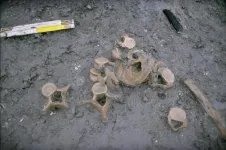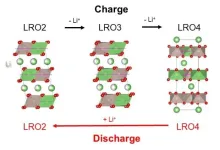(Press-News.org) PHILADELPHIA— A new analysis focusing specifically on people of African ancestry identified three gene variants that may be contributing to this population’s susceptibility to developing and being blinded by glaucoma. People of African ancestry are five times as likely as others to develop glaucoma and up to 15 times as likely to be blinded by the condition, but the vast majority of research has used data from people of European ancestry. Led by researchers at the Perelman School of Medicine at the University of Pennsylvania, the study was published today in Cell.
“Our work is an important step toward defining subgroups of glaucoma, providing the capability for early screening, and discovering targetable pathways for personalized therapeutic interventions,” said study author Rebecca Salowe, MSE, a research project manager in the lab of senior author Joan O’Brien, MD, a professor of Ophthalmology and director of the Penn Center for Genetics of Complex Disease.
Involving more than 11,200 people of African ancestry, the new study uncovered two particular variants that correlated with primary open-angle glaucoma, the most common form of glaucoma, which is the leading cause of irreversible blindness worldwide. The variants discovered in the analysis were rs1666698, tied to the gene DBF4P2, and rs34957764, linked to ROCK1P1.
In addition to identifying these two variants as “likely causal” of glaucoma, a third variant was also identified (rs11824032 tied to ARHGEF12), which was associated with cup-to-disc ratio, a measure of glaucoma severity.
The majority of previously associated variants identified in other ancestral populations did not replicate in these African ancestry subjects, which could be tied to the genetic differences that occur in these different groups.
As of 2019, only two percent of all genome-wide association studies—analyses of entire genomes to find commonalities that correlate to disease or other traits—have been conducted in individuals whose ancestry is tied to Africa. The study, led by first author Shefali Setia Verma, PhD, an assistant professor in Pathology and Laboratory Medicine, Salowe, O’Brien, and Marylyn Ritchie, PhD, a professor of Genetics and director of the Institute of Biomedical Informatics, sought to work toward addressing that disparity while also looking into a condition that disproportionately affects individuals of African ancestry. It’s also an issue Penn Medicine has worked toward for decades, utilizing wide community-focused screenings that this new research could help to inform.
"This work highlights the essential role of diversity in genetic research,” Verma said. “Without our focus on this specific ancestry group, these unique and critical insights might have remained lost, and we would not have been able to substantially enhance our understanding of the genetics behind primary open-angle glaucoma in this overaffected population."
A particular advantage that the researchers had in this study was the ability to validate their results in the Penn Medicine BioBank, an in-house repository of genetic information linked to health records. It features a particularly diverse collection of genetic material.
“To enhance our work, we were able to identify patients in the Penn Medicine BioBank with glaucoma to validate the genetic effects we gleaned from the initial cohort we analyzed,” Ritchie said. “Without that resource, it would have been much more difficult to produce such strong work.”
With the variants the researchers identified, a polygenic risk score—a measure of disease risk due to an individual’s genes—was developed that outperformed a similar risk score generated with information from an analysis of individuals of European ancestry. Having this improved risk score in hand could help patients make decisions about screening and treatment for glaucoma before it becomes a blinding illness.
“We are sharing our genetic database with other researchers across departments and schools that are studying diseases that over-affect African-ancestry populations,” O’Brien said. “These collaborations are resulting in much more research on the health of an historically understudied population.”
O’Brien also explained her team is currently doing research to discover how exactly these genes contribute to disease risk and severity.
However, with knowledge of the variants now in hand, the researchers hope to influence clinical approaches to glaucoma in this population and work toward reversing inequities that have persisted for many years.
“Glaucoma is a highly familial disease, so premature and irreversible vision loss can affect multiple family members, contributing both to adverse health and economic outcomes,” Salowe said. “With current treatments for glaucoma having limited success, there is an urgent need for large genetic studies to identify novel targets for screening and therapeutic intervention in African ancestry individuals.”
This research was funded primarily by the National Eye Institute (1R01EY023557-5701) and the Vision Research Core Grant (P30 EY001583).
###
Penn Medicine is one of the world’s leading academic medical centers, dedicated to the related missions of medical education, biomedical research, excellence in patient care, and community service. The organization consists of the University of Pennsylvania Health System and Penn’s Raymond and Ruth Perelman School of Medicine, founded in 1765 as the nation’s first medical school.
The Perelman School of Medicine is consistently among the nation's top recipients of funding from the National Institutes of Health, with $550 million awarded in the 2022 fiscal year. Home to a proud history of “firsts” in medicine, Penn Medicine teams have pioneered discoveries and innovations that have shaped modern medicine, including recent breakthroughs such as CAR T cell therapy for cancer and the mRNA technology used in COVID-19 vaccines.
The University of Pennsylvania Health System’s patient care facilities stretch from the Susquehanna River in Pennsylvania to the New Jersey shore. These include the Hospital of the University of Pennsylvania, Penn Presbyterian Medical Center, Chester County Hospital, Lancaster General Health, Penn Medicine Princeton Health, and Pennsylvania Hospital—the nation’s first hospital, founded in 1751. Additional facilities and enterprises include Good Shepherd Penn Partners, Penn Medicine at Home, Lancaster Behavioral Health Hospital, and Princeton House Behavioral Health, among others.
Penn Medicine is an $11.1 billion enterprise powered by more than 49,000 talented faculty and staff.
END
By 2060, according to the Alzheimer’s Association, nearly one in four Americans will be in an age bracket at elevated risk of cognitive decline and Alzheimer’s disease unless interventions can help preserve cognitive function before deficits begin. The COcoa Supplement and Multivitamin Outcomes Study (COSMOS) is a large-scale, nationwide, randomized trial rigorously testing cocoa extract and multivitamin supplements directed by researchers at Mass General Brigham. Two previously published studies of cognition in COSMOS suggested a positive effect for a daily multivitamin. ...
Nurse home visits to disadvantaged mothers can significantly reduce their rates of hypertension and their daughters’ likelihood of obesity, finds a new reanalysis of health data by a team led by a UCL researcher.
The study, published in the journal JAMA Network Open, reanalysed data taken as part of a Nurse-Family Partnership trial started more than 30 years ago – The Memphis New Mothers Study (1990-1994). The researchers found that prenatal and infancy nurse home visits decreased the likelihood of daughters being obese by 55% and being severely obese by 81% in adolescence. Similarly, mothers of girls showed a decrease ...
About The Study: The findings of this study that included 31 participants ages 65 to 79 suggest that older drivers, even if they regularly use cannabis, show evidence of impaired driving performance after smoking cannabis. Weaving was increased and speed was decreased at 30 minutes after smoking, which was not correlated with blood tetrahydrocannabinol (THC) concentrations; subjective experience and self-reports of impaired driving persisted for three hours.
Authors: Patricia Di Ciano, Ph.D., of the Centre for Addiction ...
About The Study: This nonrandomized controlled trial of 108 patients with advanced Parkinson disease found that at 5-year follow-up quality of life remained stable in the deep brain stimulation of the subthalamic nucleus (STN-DBS) group and worsened in the standard-of-care medication group, mainly driven by the favorable effect of STN-DBS on mobility. These findings may provide helpful information when counseling patients on the efficacy of STN-DBS for Parkinson disease and monitoring patients postoperatively in long-term follow-up.
Authors: Stefanie T. Jost, Ph.D., and Haidar S. Dafsari, M.D., of the University of Cologne, Germany, are the corresponding ...
Philadelphia, PA (January 18, 2024) – Understanding why we overeat unhealthy foods has been a long-standing mystery. While we know food's strong power influences our choices, the precise circuitry in our brains behind this is unclear. The vagus nerve sends internal sensory information from the gut to the brain about the nutritional value of food. But, the molecular basis of the reward in the brain associated with what we eat has been incompletely understood.
Now, a new study published in Cell Metabolism by a team from the ...
What did people eat on the west coast of Scandinavia 10 000 years ago? A new study of the DNA in a chewing gum shows that deer, trout and hazelnuts were on the diet. It also shows that one of the individuals had severe problems with her teeth.
Some 9 700 years ago, a group of people were camping on the west coast of Scandinavia, north of what is today Göteborg. They had been fishing, hunting and collecting resources for food. And some teenagers, both boys and girls, were chewing resin to produce glue, just after ...
1. A research team consisting of the National Institute for Materials Science (NIMS) and Softbank Corp. has found that voltage hysteresis in Li2RuO3—a high-energy-density rechargeable battery cathode material—is caused by differences in the intermediate crystalline phases formed during charge and discharge processes. Voltage hysteresis is a phenomenon detrimental to lithium (Li)-ion batteries in which discharge voltage becomes significantly lower than charge voltage. These results revealed a voltage-hysteresis-causing mechanism inconsistent with conventional theory.
2. ...
In the switch to “greener” energy sources, the demand for rechargeable lithium-ion batteries is surging. However, their cathodes typically contain cobalt — a metal whose extraction has high environmental and societal costs. Now, researchers in ACS Central Science report evaluating an earth-abundant, carbon-based cathode material that could replace cobalt and other scarce and toxic metals without sacrificing lithium-ion battery performance.
Today, lithium-ion batteries power everything from cell phones to laptops to electric vehicles. One of the limiting factors for realizing a global shift to energy produced by renewable sources — particularly for the transition ...
The College of Engineering and Computer Science of Florida Atlantic University received a $2.6 million grant from the National Science Foundation (NSF) to establish a scholarship program in the burgeoning and critical field of cybersecurity. The NSF’s CyberCorps® Scholarship for Service program seeks to increase the number of qualified cybersecurity professionals working for federal, state, local, territorial and tribal governments.
The program is managed by the NSF in collaboration with the United States Office of Personnel Management and the U.S. Department of Homeland Security. FAU is one of only six universities ...
In a groundbreaking study published on January 18, 2024, in Cancer Discovery, scientists at University of California San Diego School of Medicine leveraged a machine learning algorithm to tackle one of the biggest challenges facing cancer researchers: predicting when cancer will resist chemotherapy.
All cells, including cancer cells, rely on complex molecular machinery to replicate DNA as part of normal cell division. Most chemotherapies work by disrupting this DNA replication machinery in rapidly dividing tumor ...




